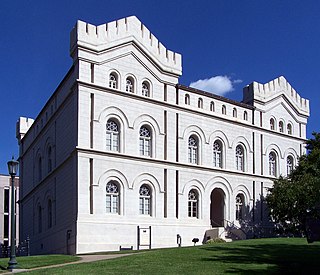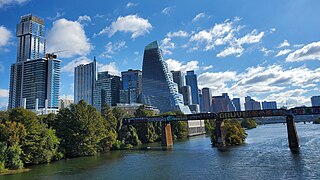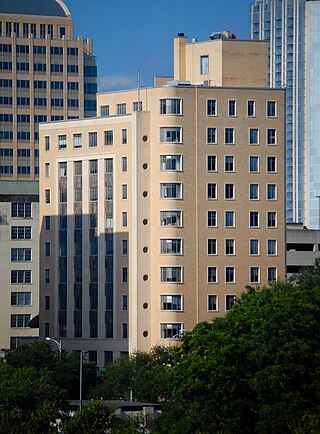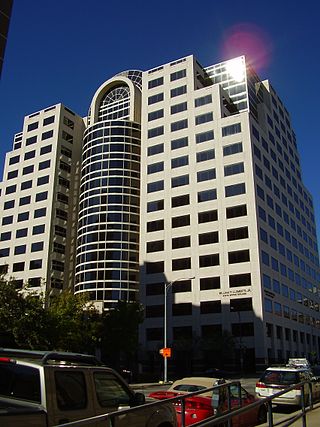
The University of Texas System is a public university system in the U.S. state of Texas. It includes nine universities and five independent health institutions. The UT System is headquartered in Downtown Austin. Its total enrollment of nearly 240,000 students is the largest university system in Texas. It employs 21,000 faculty and more than 83,000 health care professionals, researchers and support staff. The UT System's $42.7 billion endowment is the largest of any public university system in the United States.

Downtown is the largest central business district in the city of Houston and the largest in the state of Texas, located near the geographic center of the metropolitan area at the confluence of Interstate 10, Interstate 45, and Interstate 69. The 1.84-square-mile (4.8 km2) district, enclosed by the aforementioned highways, contains the original townsite of Houston at the confluence of Buffalo Bayou and White Oak Bayou, a point known as Allen's Landing. Downtown has been the city's preeminent commercial district since its founding in 1836.

The Texas State University System (TSUS) is a Public university system in Texas. It was created in 1911 to oversee the state's normal schools. It has since broadened its focus and comprises institutions of many different scopes.

The Civic Center neighborhood of Los Angeles, California, is the administrative core of the City of Los Angeles, County of Los Angeles, and a complex of city, county, state, and federal government offices, buildings, and courthouses. It is located on the site of the former business district of the city during the 1880s and 1890s, since mostly-demolished.

The General Land Office Building, completed in 1857, in Austin, Texas is the oldest surviving state government office building in the city and the first building designed by a university-trained architect. The building features a dramatic medieval castle style known as Rundbogenstil, or "rounded arch" around the windows and doors. There is also a Norman style influence in the castle-like parapets. The exterior walls are limestone rubble smoothed over with stucco and scored to simulate cut stone blocks.

Downtown San Antonio is the central business district of San Antonio, Texas and the urban core of Greater San Antonio, a metropolitan area with nearly 2.5 million people.

Downtown Fort Worth is the central business district of Fort Worth, Texas, United States. Most of Fort Worth's tallest buildings and skyscrapers are located downtown.

Downtown Austin is the central business district of Austin, Texas, United States. The area of the district is bound by Lamar Boulevard to the west, Martin Luther King Jr. Boulevard to the north, Interstate 35 to the east, and Lady Bird Lake to the south.

Alfred Charles Finn was an American architect. He started in the profession with no formal training in 1904 as an apprentice for Sanguinet & Staats. He worked in their offices in Dallas, Fort Worth, and Houston. His credits during his tenure residential structures, but firm was a leader in steel-frame construction of skyscrapers.

The Sam B. Hall Jr. Federal Building and United States Courthouse, formerly known as the Marshall Federal Building and U.S. Post Office, was built in 1915. It is a Classical Revival building designed by Oscar Wenderoth and George Shaul.

The Texas Film Commission is a state agency of Texas, under the oversight of the Governor of Texas. Its headquarters are in Suite 3.410 in the Texas Insurance Building in Downtown Austin.
Alta Architects is an American architecture firm based in San Antonio, Texas. Founded in 1927 as Eickenroht & Cocke, the firm specializes in the design of major academic, K-12, healthcare, scientific and infrastructure projects. It is the largest minority-owned design and management firm in the state of Texas.

The Texas Department of Licensing and Regulation (TDLR) is a state agency of Texas.

Downtown Dallas is the central business district (CBD) of Dallas, Texas, United States, located in the geographic center of the city. It is the second-largest business district in the state of Texas. The area termed "Downtown" has traditionally been defined as bounded by the downtown freeway loop, bounded on the east by I-345 (although known and signed as the northern terminus of I-45 and the southern terminus of US 75, on the west by I-35E, on the south by I-30, and on the north by Woodall Rodgers Freeway.
Algernon Blair was a construction contractor in Montgomery, Alabama. He worked on many government building projects including county courthouses and U.S. post offices. He was a member of The Thirteen, a literary and philosophical society. Several of his firm's buildings are listed on the U.S. National Register of Historic Places.

Texas Department of Information Resources (DIR) is a state agency of Texas. It has its headquarters in Suite 1300 in the William P. Clements Building in Downtown Austin.
Lawrence Speck is an American architect and professor. He is a senior principal with Page Architects and a professor at the University of Texas at Austin, where he holds the W. L. Moody Centennial Professorship in Architecture. He is one of the former presidents of the Texas Society of Architecture. He was a dean of the School of Architecture at the University of Texas at Austin from 1992 to 2001 and served as the founding director of the Center of American Architecture and Design from 1982 to 1990. He attended the Massachusetts Institute of Technology (M.I.T.), receiving bachelor's degrees in design and management, as well as a Master of Architecture.

The Austin United States Courthouse is a historic former federal courthouse in downtown Austin, Texas. Built between 1935 and 1936, the building exemplifies Depression-era Moderne architecture, while Art Moderne and Art Deco finishes characterize the interior. It housed the Austin division of the United States District Court for the Western District of Texas and other judicial offices until 2012, when a new federal courthouse building was completed. Since 2016 the building has been owned by Travis County, and it has housed the county probate courts since 2020. The structure was added to the National Register of Historic Places in 2001.

Indeed Tower is an office skyscraper located at 200 West Sixth Street in Downtown Austin, Texas. The tower is the sixth tallest in Austin at 542 feet. It is the second largest office tower in Austin at 709,000 total square feet as well as the second tallest, behind Block 185. Indeed Tower is made up of a 683,000-square-foot Class AA office tower with two rooftop terraces and ground floor retail, a historic 1914 post office repurposed as a 25,000 square-foot retail and restaurant destination, and a 20,000 square-foot urban greenspace. There are five levels of underground parking and 12 floors of above-ground parking as part of the structure.



















